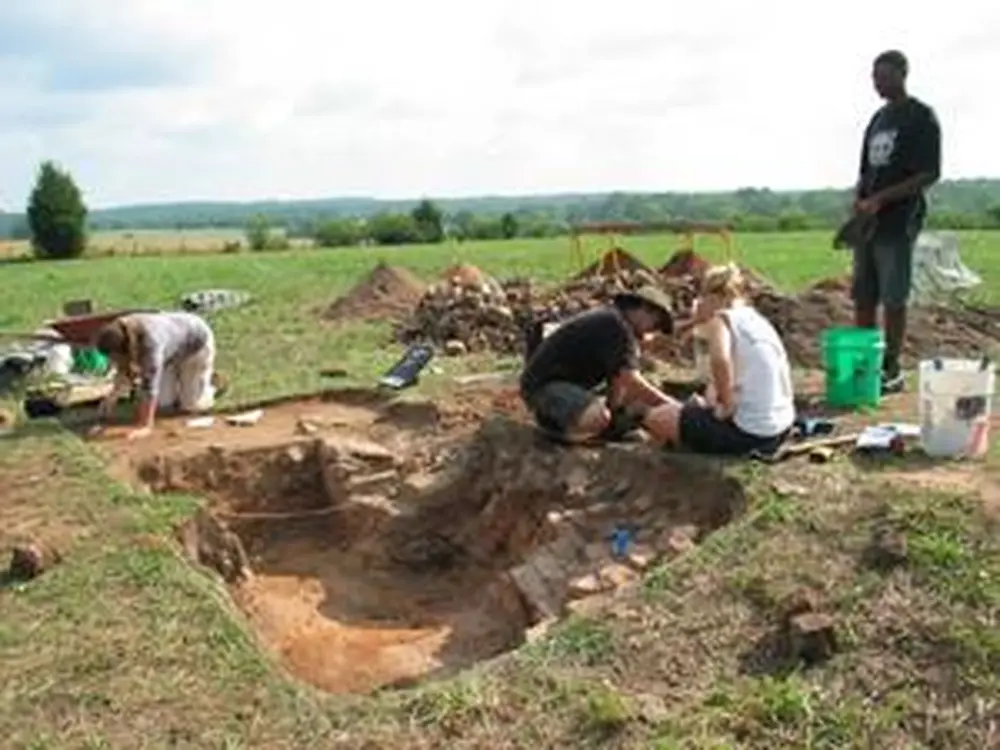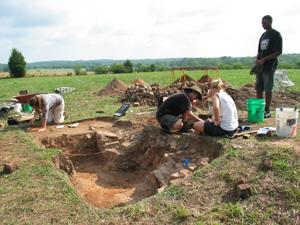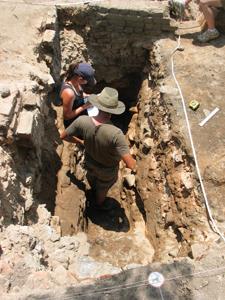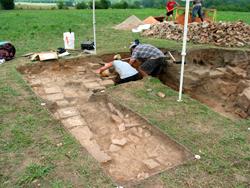

Dave the Potter was openly breaking state law when he inscribed his name, along with poetry and Bible verses, in the pottery he created in South Carolina. That’s because it was illegal in the early 19th century for a slave like Dave to read or write, let alone propagate simple inscribed rhymes such as:
I wonder where is all my relation
Friendship to all—and, every nation”
Today, pottery created by Dave the Potter can be found in museums across the world, including the Smithsonian. University of Illinois anthropologists have now gone back to the source of this amazing craftsmanship, unearthing the Pottersville kiln where it is believed that Dave became a master potter. This kiln was also the first to use alkaline glazing in North America—a major breakthrough in pottery.
From May through June, anthropology graduate student George Calfas led a team of undergraduate students, including five LAS students. Working in muggy, 100-degree weather, they uncovered the industrial-scale kiln used to make pottery at Pottersville, about a mile from Edgefield, S.C.

According to Calfas, until the early 1800s, potters used either a lead or salt glazing to seal their pots. But it was too expensive to transport salt to South Carolina, and physicians had discovered the deadly risk of poisoning from lead glazing. As a result, Abner Landrum, who founded Pottersville, became the first American to use alkaline glazing—a method used in China but not in North America and Europe at the time.
In 1820, the Edgefield district was the third largest populated area in the South, so Pottersville put out huge numbers of vessels, ranging in size from a half gallon to 20 gallons.
“To pickle enough pork for the enslaved population of 13,000 in the Edgefield area, you had to have 11,000 five-gallon vessels just for pork alone,” Calfas points out.
Calfas’s team has uncovered up to 10,000 bits of stoneware, but they have not found any complete pots. This comes as no surprise because, as he explains, “What we’re looking at are the ‘wasters,’ the bits and pieces of pots leftover from breakages in the kiln.”
Calfas entered the Illinois anthropology program after 14 years of military service, where he had his first taste of archaeology. As an airborne ranger, he was part of a team that went to Laos, Cambodia, and Vietnam searching for the remains of fallen American soldiers. In all, he made three trips and helped recover the remains of 14 soldiers.
Today, Calfas is working under anthropology professor Christopher Fennell, and he sees the Edgefield dig as possibly becoming a career-long venture. But for anthropology undergraduates such as senior Lindsay Foster, it was their first taste of excavation.

“It’s been fascinating to apply the things I learn in class to actual, hands-on experience,” she says. For instance, she learned how to make “shovel test pits”—20-inch by 20-inch holes that tell them where to make larger excavations on the 500-acre site.
“The pots are beautiful,” Foster says, “and the history of Dave the Potter is huge around here. Everyone talks about Dave’s pots.”
According to Calfas, people believe that Dave had the ability to add inscriptions to his pots because he learned to read and write while setting type for The Hive, a newspaper operated by the Pottersville founder, Abner Landrum. Dave even took the opportunity to tweak his own master, Lewis Miles, with one of his inscriptions: “Lm says this handle will crack.”
Evidently, the master didn’t think the handle would last. But 150 years later, it’s clear who was right. Dave’s handle still holds strong.


